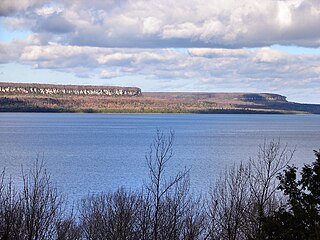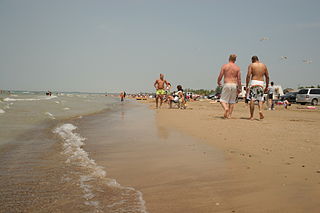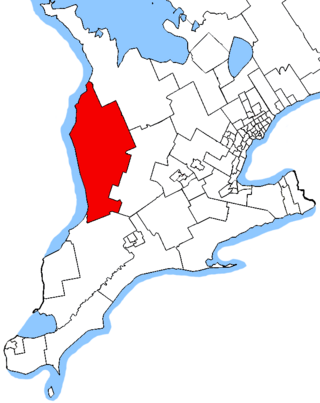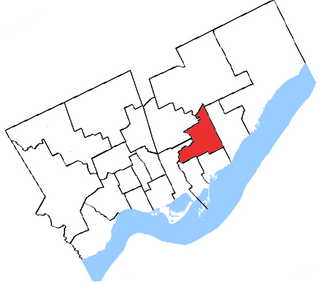
South Bruce Peninsula is a town at the base of the Bruce Peninsula of Ontario, Canada, in Bruce County between Lake Huron and Georgian Bay. It was formed on January 1, 1999, when the town of Wiarton, the village of Hepworth, and the townships of Albemarle and Amabel were amalgamated. The new municipality was created to provide necessary political representation, administrative support, and necessary municipal services on behalf of the residents.

Bruce County is a county in Southwestern Ontario, Canada. It has eight lower-tier municipalities with a total 2016 population of 66,491. It is named for James Bruce, 8th Earl of Elgin and 12th Earl of Kincardine, the sixth Governor General of the Province of Canada. The Bruce name is also linked to the Bruce Trail and the Bruce Peninsula.

Sauble Beach is a beach community and unincorporated area in the town of South Bruce Peninsula, Bruce County, in the northern area of southwestern Ontario, Canada. It is on the Bruce Peninsula, along the eastern shore of Lake Huron, on the north edge of the Saugeen First Nation. The beach takes its name from that given by early French explorers to the sandy Sauble River, originally "La Rivière Au Sable" also indicating that the river emptied into Lake Huron at a sandy beach. The river was labelled with the French name on maps until 1881, when it became the Sauble River; in early years, a sawmill was built on the river, and later, a hydro electric plant.

Southampton is a community on the shores of Lake Huron in Bruce County, Ontario, Canada. It is close to Port Elgin and is located at the mouth of the Saugeen River in the Saugeen Ojibway Nation Territory. The size of the town is 6.44 square kilometres. The permanent population in 2016 was 3,678, but the summer population is higher since cottagers and campers spend vacation time in the area.

Huron—Bruce is a federal electoral district in Ontario, Canada, that has been represented in the House of Commons of Canada since 1953.
Bruce South was a federal electoral district in Ontario, Canada, that was represented in the House of Commons of Canada from 1867 to 1882 and from 1903 to 1935.
Elgin East was a federal electoral district represented in the House of Commons of Canada from 1867 to 1925. It was located in the province of Ontario. It was created by the British North America Act of 1867 which divided the county of Elgin into two ridings: Elgin East and Elgin West based on a traditional division.
Elgin West was a federal electoral district represented in the House of Commons of Canada from 1867 to 1935. It was located in the province of Ontario. It was created by the British North America Act of 1867 which divided the county of Elgin into two ridings: Elgin East and Elgin West based on a traditional division.
Grey North was a federal electoral district represented in the House of Commons of Canada from 1867 to 1968. It was located in the province of Ontario. It was created by the British North America Act of 1867, which divided the County of Grey into two ridings: Grey South and Grey North. The North Riding consisted of the Townships of Collingwood, Euphrasia, Holland, Saint-Vincent, Sydenham, Sullivan, Derby, and Keppel, Sarawak and Brooke, and the Town of Owen Sound.
Huron North was a federal electoral district represented in the House of Commons of Canada from 1867 to 1882, and from 1917 to 1953. It was located in the province of Ontario. It was created by the British North America Act of 1867 which divided the County of Huron into two ridings: Huron North and Huron South.
Huron South was a federal electoral district in Ontario, Canada, that was represented in the House of Commons of Canada from 1867 to 1935. It was created by the British North America Act of 1867 which divided the County of Huron into two ridings: Huron North and Huron South.
Middlesex East was a former federal electoral district in Ontario, Canada, represented in the House of Commons of Canada from 1867 to 1968. It was created by the British North America Act of 1867, which divided the County of Middlesex into three ridings: Middlesex North, Middlesex West and Middlesex East.
Ontario North was a federal electoral district represented in the House of Commons of Canada from 1867 to 1925. It was located in the province of Ontario. It was created by the British North America Act of 1867.
Oxford North was a federal electoral district represented in the House of Commons of Canada from 1867 to 1935. It was located in the province of Ontario. It was created by the British North America Act of 1867.
Perth North was a federal electoral district represented in the House of Commons of Canada from 1867 to 1935. It was located in the province of Ontario. It was created by the British North America Act of 1867 which divided the County of Perth into two ridings.

York East was a federal electoral district represented in the House of Commons of Canada at different times. It was located in the province of Ontario.
Bruce West was a federal electoral district in Ontario, Canada, that was represented in the House of Commons of Canada from 1882 to 1904. This riding was created in 1882 from parts of Bruce North and Bruce South ridings.

Saugeen Shores is a town in Bruce County, Ontario, Canada, formed in 1998. In addition to the two main population centres of Southampton and Port Elgin, the town includes a portion of the village of Burgoyne and the North Bruce area, straddling the municipal eastern and southern boundary respectively. In 2016, the permanent population of Saugeen Shores was 13,715, in a land area of 171.05 square kilometres (66.04 sq mi).
Also within the Bruce census division are two First Nations reserves:
The Wellington, Grey and Bruce Railway (WG&BR) was a railway in Ontario, Canada. It ran roughly northwest from Guelph to the port town of Southampton on Lake Huron, a distance of 101 miles (163 km). It also had a 66-mile (106 km) branch line splitting off at Palmerston and running roughly westward to Kincardine, another port town. A branch running south from Southampton was built during the construction of the Bruce Nuclear Generating Station in the 1970s.





